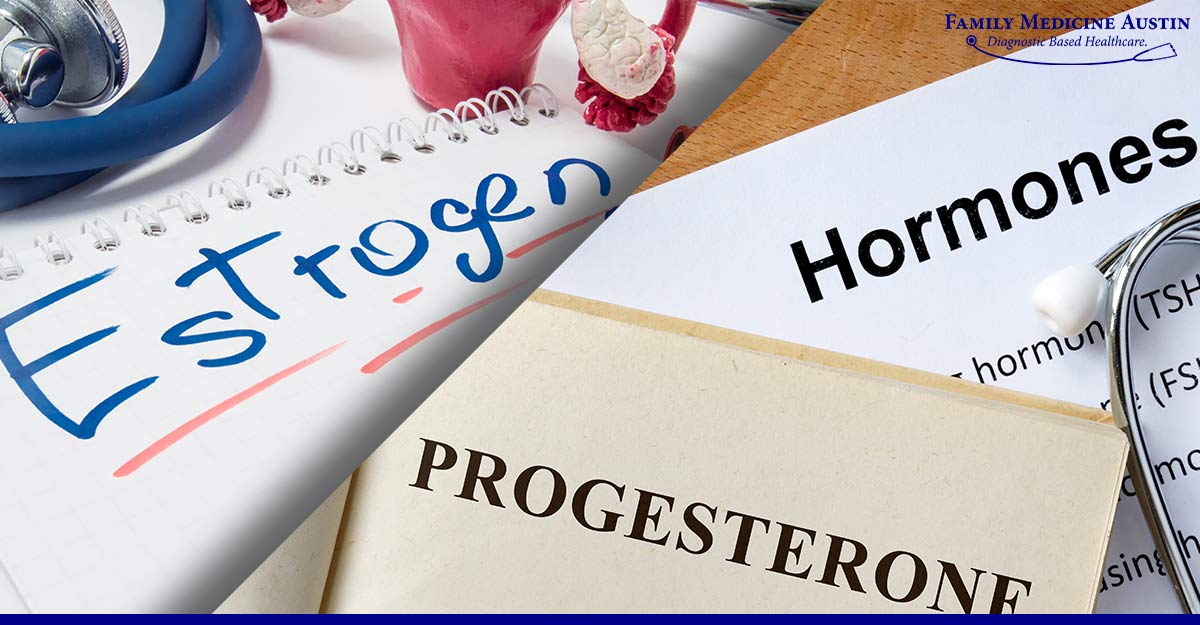
Almost all functions in your body are regulated by hormones. For example, insulin helps store glucose molecules after you’ve had a meal, and growth hormone helps you grow proportionally during puberty.
Similarly, estrogen and progesterone are two critical female hormones (present in small levels in males too) that are important for the development of sexual characteristics and reproductive functions. These hormones also play extremely crucial roles in the monthly menstrual cycle.
An imbalance of estrogen and progesterone can cause underdevelopment in females, irregular periods, infertility, and other uterine disorders.
In this article, let’s take a look at the roles of these hormones in the human body and compare estrogen vs. progesterone to understand the importance of each.
Estrogen and progesterone are steroid hormones that are important in all bodies – male, female and intersex – although they are higher in biological females. They are both important for the menstrual cycle and maintenance of pregnancy in females and are combinedly prescribed in birth control pills and hormone replacement therapy for menopause.
Estrogen is a sex hormone that you start producing at puberty.
In women, estrogen stimulates the development of sexual characteristics like the development of breasts, widening of hips, and growth of pubic and armpit hair.
In the uterus, estrogen promotes the proliferation of the inner lining of the uterus to prepare the body for fertilization and embryo plantation of an embryo. It also stimulates lubrication of the vaginal canal to promote the propulsion of sperm up into the uterus.
In males, estrogen is important for erectile function and the production of sperm promotes good bone health and regulates mood. This is why women in menopause with lower estrogen levels are more prone to developing osteoporosis!

Progesterone is commonly known as the ‘pregnancy hormone’ because of the vital role it plays during pregnancy.
In females, it is produced from the corpus luteum – a temporary gland formed from a remnant of an ovarian follicle that arises in the latter half of the menstrual cycle. It enhances the proliferation of the uterine lining to make it thick, spongy, and well-vascularized with lots of coiled arteries. If the egg is fertilized and an embryo is implanted in the layer, progesterone levels rise to maintain the pregnancy to full term. If not, progesterone levels fall significantly; bringing about menses.
In men, progesterone is produced in the adrenal glands and is important for the maturation of sperm and the production of testosterone.
Estrogen gives females secondary sexual characteristics like breasts, and pubic and armpit hair. It controls the fatty deposition in breasts and the development of the glandular ducts. Estrogens stimulate prolactin secretion for the production of breast milk.
Progesterone is required for the development and growth of glandular buds in the breasts and prepares the breasts to produce milk. Progesterone also inhibits prolactin (the lactation hormone) during pregnancy so lactation begins only after delivery.
Estrogen is released in the first half of the menstrual cycle and stimulates the proliferation of the mucous layer within the uterine wall. After menses, it encourages the regeneration of blood supply to the uterine lining. Estrogen levels fall right after ovulation.
Progesterone is released in the second half of the menstrual cycle and maintains and thickens the mucosal lining. It promotes the growth of coiled arteries and capillaries within this layer to make it well-vascularised and compatible with the implantation of an embryo. Progesterone levels fall right before menstruation.
Estrogen lowers the threshold for contractions and induces labor at full term. It stimulates the enlargement of the uterus and the breasts during pregnancy and improves the blood supply to the placenta and the baby.
Progesterone raises the threshold for contractile stimuli in the uterus to prevent contractions during pregnancy which can cause preterm labor. It stimulates the enlargement of the mammary glands within the breasts to prepare for the production of milk. Progesterone thickens the mucus plug in the cervix during pregnancy so that additional sperm may not penetrate the uterus (unlike estrogen, which enhances lubrication of the vagina for easier sperm penetration).
After menopause, the body has depleted levels of estrogen and progesterone because there are no more eggs in the ovaries. Low hormone levels cause many symptoms like hot flashes, night sweats, and irregular bleeding.
Hormone replacement therapy with estrogen and progesterone can alleviate these symptoms. Intake of estrogen can solve most menopausal problems. Then why do doctors recommend a combination of estrogen and progesterone vs. just estrogen for HRT?
This is because estrogen alone can thicken the uterine lining and increase the chances of uterine or cervical cancer. Progesterone, however, reduces this risk and helps lessen other symptoms of menopause.
There are two options available for birth control pills – a progesterone pill and a combination of estrogen and progesterone pill. Many women want to know the mechanism of action of the progesterone pill vs. the estrogen pill.
The progesterone pill stimulates the thickening of the mucus plug at the base of the uterus to prevent sperm from entering the uterus and fertilizing the egg. The estrogen combination pill, however, prevents the follicle from ovulating so that there is no mature egg to fertilize even if the sperm reaches the uterus.
Estrogen and progesterone are both critical hormones that coordinate and support reproductive functions. The role of estrogen vs. progesterone may be more potent across body systems; however, most reproductive processes cannot progress without progesterone. Arguably, their most important functions are regulating the menstrual cycle and bringing about physical changes during pregnancy.
If you have any questions regarding hormones and women’s health, visit the Family Medicine Austin blog page and find out all you want to know!